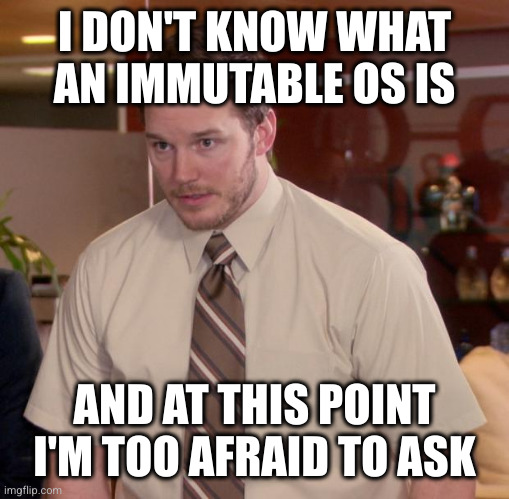this post was submitted on 24 Jul 2024
515 points (97.8% liked)
linuxmemes
25924 readers
503 users here now
Hint: :q!
Sister communities:
Community rules (click to expand)
1. Follow the site-wide rules
- Instance-wide TOS: https://legal.lemmy.world/tos/
- Lemmy code of conduct: https://join-lemmy.org/docs/code_of_conduct.html
2. Be civil
- Understand the difference between a joke and an insult.
- Do not harrass or attack users for any reason. This includes using blanket terms, like "every user of thing".
- Don't get baited into back-and-forth insults. We are not animals.
- Leave remarks of "peasantry" to the PCMR community. If you dislike an OS/service/application, attack the thing you dislike, not the individuals who use it. Some people may not have a choice.
- Bigotry will not be tolerated.
3. Post Linux-related content
- Including Unix and BSD.
- Non-Linux content is acceptable as long as it makes a reference to Linux. For example, the poorly made mockery of
sudoin Windows. - No porn, no politics, no trolling or ragebaiting.
4. No recent reposts
- Everybody uses Arch btw, can't quit Vim, <loves/tolerates/hates> systemd, and wants to interject for a moment. You can stop now.
5. 🇬🇧 Language/язык/Sprache
- This is primarily an English-speaking community. 🇬🇧🇦🇺🇺🇸
- Comments written in other languages are allowed.
- The substance of a post should be comprehensible for people who only speak English.
- Titles and post bodies written in other languages will be allowed, but only as long as the above rule is observed.
6. (NEW!) Regarding public figures
We all have our opinions, and certain public figures can be divisive. Keep in mind that this is a community for memes and light-hearted fun, not for airing grievances or leveling accusations. - Keep discussions polite and free of disparagement.
- We are never in possession of all of the facts. Defamatory comments will not be tolerated.
- Discussions that get too heated will be locked and offending comments removed.
Please report posts and comments that break these rules!
Important: never execute code or follow advice that you don't understand or can't verify, especially here. The word of the day is credibility. This is a meme community -- even the most helpful comments might just be shitposts that can damage your system. Be aware, be smart, don't remove France.
founded 2 years ago
MODERATORS
you are viewing a single comment's thread
view the rest of the comments
view the rest of the comments

Immutable in this context refers to an OS that can't be changed while running. Steam deck does something like that. Basically the all of the OS system files are read only, so that the user or some malware can't Bork the system. The only parts that are writable are the users profile directory and the logs.
You can still receive updates and install apps. It's just that that's handled a bit differently than with a standard OS.
E.g. it could be that the OS provider only issues complete updates, and then you either have to reboot. This is the case with steam os on the steam deck. The System portion of the OS is mounted read only during use.
Another prominent example is Android. Sure system apps can be upgraded individually -- by storing the new version in a restricted part of the 'user' partition -- but otherwise the system files are strictly read only until a new 'image' is 'flashed' to it by the update system or a power user with debugging tools. In the past, a common use of root capabilities was to remount the system partition as read/write and then change files on it directly. It's more complex now.
That's also why system apps can be rolled back to the stock version, and can sometimes be disabled, but can't be directly uninstalled like user apps. Only the updated version on the user partition (if there is one) can be removed.
Aren't apps better compareable to something like flatpack and this is the reason why they are updateable during runtime?
Sure they are, but system apps are still installed in the immutable space initially, which is the important thing, that updates to it can't go there.
I don't know how desktop immutable systems deal with that.
You can update the whole base image. Vanilla OS and SteamOS have an A/B partition that holds the currently-in-use image and can also hold a to-be-used image.
Updating works by adding the to-be-used image, setting a configuration option that tells the system to boot that one, and on the next boot it'll check if the new one is bootable, then either boot it and mark it as working, or boot into the old one and display an error about how out wasn't able to boot into the new one.
There's smart things going on like maybe hard linking files that didn't change between the two images and therefore saving space and copying time.
The result is that you never have a broken system, but you can still frequently update the base image.